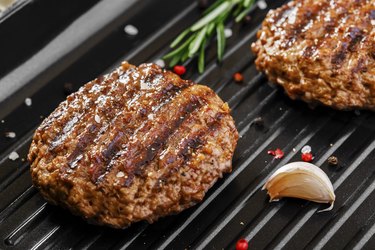
Although you should expect some shrinkage when you cook hamburgers, you can take measures to minimize it. The effect happens when you use ground meats of all kinds, whether turkey, chicken, low-fat beef or high-fat beef. Luckily, the solutions work for all types of meat and poultry -- for hamburgers cooked on the grill outdoors, or for those cooked in a skillet in your kitchen.
Causes of Shrinkage
Video of the Day
When meat and poultry muscle fibers change their shape during cooking, shrinkage inevitably occurs. Before cooking, the protein molecules in the muscles are coiled together. During cooking two things happen: The bonds between the fibers uncoil and lengthen, and then they recombine into longer units, a process called coagulation. Both processes, called denaturing since the protein loses its "natural" shape, result in water being forced out of the cells and the burger shrinking before your eyes.
Video of the Day
Use Lean Beef
Leaner cuts of ground meat and poultry lose less water and shrink less than more fatty cuts. For example, a 2012 study by the U.S. Department of Agriculture found that a low-fat, grilled beef patty retained 73 percent of its volume while a high-fat patty retained 63 percent of its volume. But your burger also loses flavor and juiciness when you use leaner beef; the choice is yours whether to sacrifice a certain amount of flavor to reduce shrinkage.
Create a Small Dimple
Changing the shape of the hamburger patty helps minimize shrinkage. If you press a small indentation in the center of the burger with your thumb before cooking, the patty remains flat instead of puffing up in the center. For a 4-ounce patty, create a depression about the size of a nickle in diameter and about 1/4 inch deep.
Make Larger Burgers
Shape the raw burger patties so they are larger than the burger buns to help minimize the effects of shrinkage. This way, the patty shrinks to roughly the same size as the buns instead of being smaller. The method works particularly well if you also make the indentation in the center of the patty. Be careful not to overwork the raw meat as you form the patty because that causes more of the protein fibers in the patty to change their shape and release water.